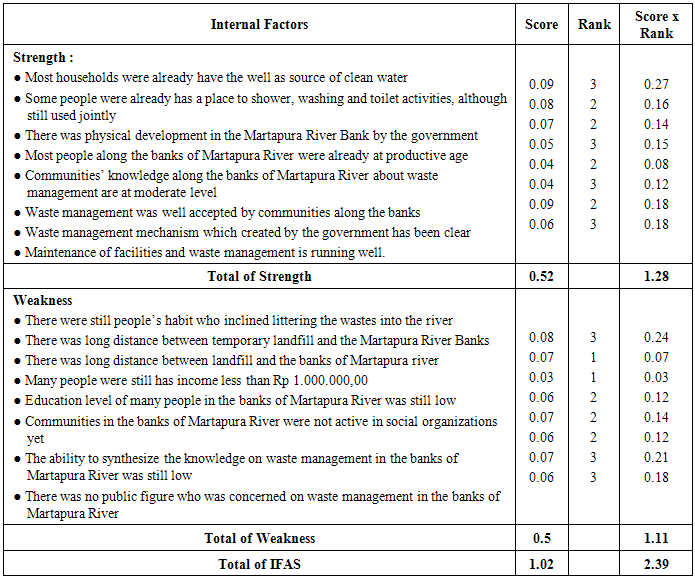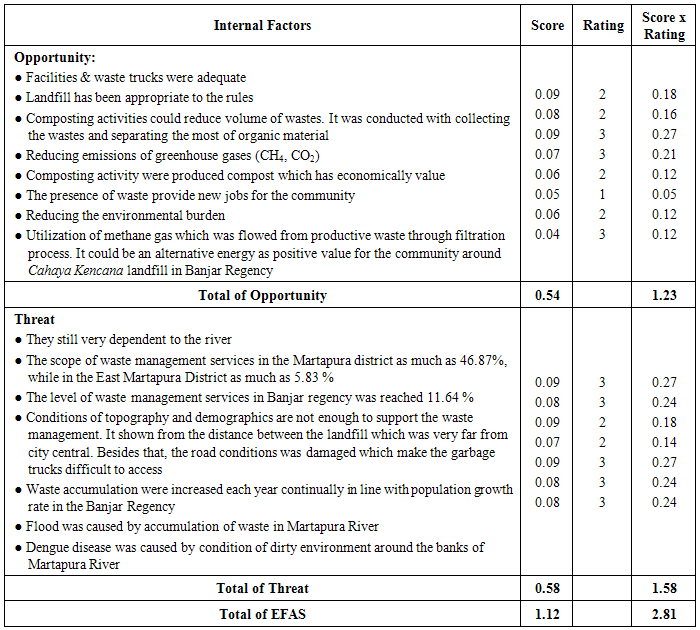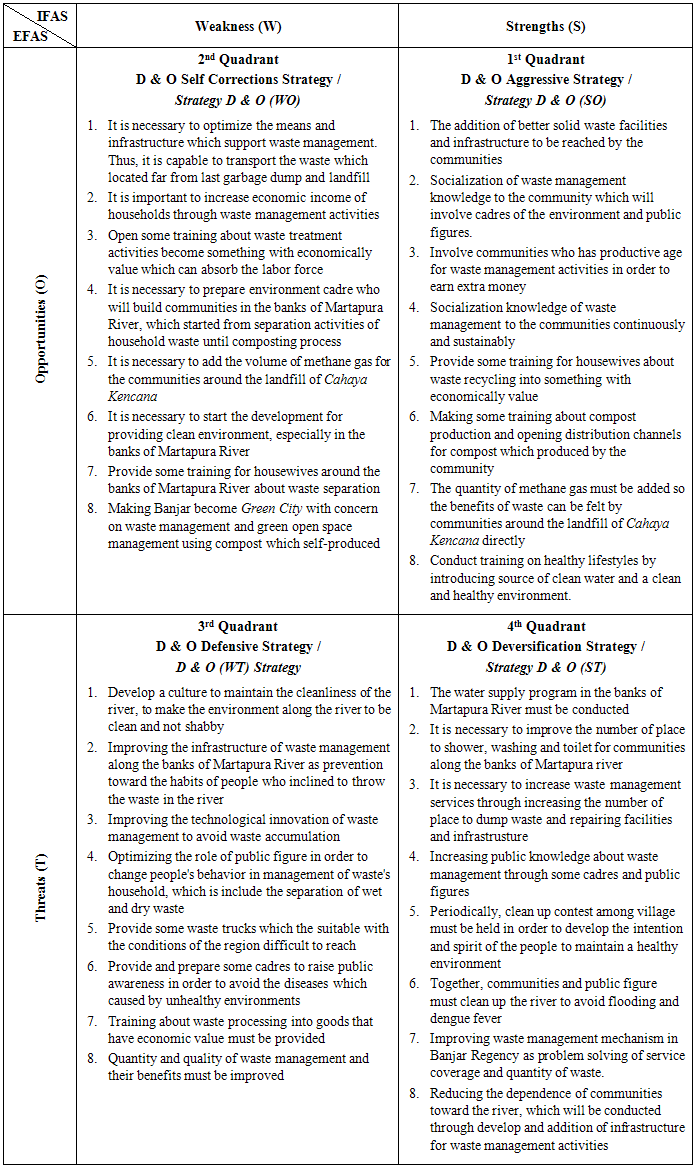-
Paper Information
- Previous Paper
- Paper Submission
-
Journal Information
- About This Journal
- Editorial Board
- Current Issue
- Archive
- Author Guidelines
- Contact Us
Resources and Environment
p-ISSN: 2163-2618 e-ISSN: 2163-2634
2015; 5(3): 97-105
doi:10.5923/j.re.20150503.03
Social Engineering Strategy of Waste Management in River Banks of Martapura
Rahmaddin MY1, 2, Taufik Hidayat3, Bagyo Yanuwiadi4, Suyadi5
1Doctoral Program of Environmental Studies, Graduate Program, University of Brawijaya, Malang, Indonesia
2Public Relation of Banjar Regency, Indonesia
3Department of Agribusiness, Faculty of Agriculture, Lambung Mangkurat University, Banjarmasin, Indonesia
4Department of Biology, Faculty of Mathematics and Natural Sciences, University of Brawijaya, Malang, Indonesia
5Department of Livestock Product Technology, University of Brawijaya, Malang, Indonesia
Correspondence to: Suyadi, Department of Livestock Product Technology, University of Brawijaya, Malang, Indonesia.
| Email: |  |
Copyright © 2015 Scientific & Academic Publishing. All Rights Reserved.
The aim of this study is to develop a strategy of social engineering, especially on the waste management in river banks of Martapura. This research is expected to become data base in improving waste management system to be better and sustainable. There were three types of analysis methods which were used in this study, i.e. SWOT, EFAS and IFAS analysis. We also used three strategies to improve waste management, to develop social engineering of waste management in the river bank of Martapura, e.g. concentric strategy, diversifying strategy and normative – re-educative strategy. The result showed that social engineering was very important to change the behaviour of people toward waste management in the river banks of Martapura. Responsibility of waste management in the banks of the Martapura River is not only for government but also for all community surround the area. Related with it, social engineering is necessary to lead people around the area in the way of better waste management and responsible to their environment, thus maintain the environment, social, and economic balance.
Keywords: Behaviour, EFAS, IFAS, Martapura River Bank, Social engineering, SWOT, Waste management
Cite this paper: Rahmaddin MY, Taufik Hidayat, Bagyo Yanuwiadi, Suyadi, Social Engineering Strategy of Waste Management in River Banks of Martapura, Resources and Environment, Vol. 5 No. 3, 2015, pp. 97-105. doi: 10.5923/j.re.20150503.03.
Article Outline
1. Introduction
- Some problems in waste handling were lead to imbalance between production and capability in management. Thus waste volume increase continuously in line with population growth, life quality changes and dynamics of community activities. Some negative effects also occurs when waste was not well managed, e.g. health problems, causing bad odour, soil and water pollution, and environment become less clean and less beauty. In Indonesia, waste management still become essential problem for government and community. People less aware about the negative effect of waste accumulation and they have less participation to handle it. Besides that, the government budget was still not sufficient to fulfil the proper and qualified waste disposal. In Banjar Regency, most of wastes were come from household or settlements as much as 69.40%, from temporary market and Batuah Bauntung Market for 17.34%, 6.32% from public facilities area and 6.94% from other sources [1]. Related to this fact, in the study site of Antasan Senor Ilir village, most of waste was derived from household which reached 7.34 m3 per day, while 1.41 m3 per day from trade area, 2.07 m3 per day from public facilities area and 1.23 m3 from public roads. If the whole wastes were not handled properly, it will influence the environment health. Based on this data, waste management efforts in the banks of Martapura River are still very limited. This means that the budget allocation is lack for socialization, planning, and implementation of waste management services along the river. The results of Ministry of Environment publication in 2009 about Environmental Quality Index showed that South Kalimantan was ranked in 26 out of 33 provinces with 48.25 point. South Kalimantan has 8.40 for water quality index. Banjar regency was ranked 10 out of 13 regencies/cities with heavily water polluted conditions criteria. It was shown by the water quality index i.e. BOD value was 8.29 mg.lt-1 and COD value was 17.008 mg.lt-1 [1]. This fact showed that the level of pollution in the river is fairly high.Wastes were defined as something that is not useful anymore, so it discarded by the origin owners or users [2-5]. In this case, the Government must responsible to provide some facilities to collect and dispose waste from settlement adequately. However in fact, it was still not implemented as expected, because there were other things that should be prioritized in area development as well as the lack of funds allocated for waste management operations. This condition was strengthened by the principles for producer is not implemented yet. This principle tells that simultaneous producing process must also have waste management process from goods proficiency level.Generally, waste problems arise because of low community engagement efforts and internalization process since they developed the program. Soekanto [6] and Sunarto et al. [7] reported that changes have been planned in advance by those who want to make changes in society; which was called agent of change. They usually are person or group of people with public confidence as a leader of one or more social institutions. This social engineering is needed in order to make social change thus the consciousness and behaviour of the public on waste management can be improved. Assessment of social engineering of waste management is a very interesting and strategic study. This study is an attempt to overcome the problem of waste on the banks of the Martapura River related to the increasing amount of waste.Social engineering is the art of scientific manipulation movement from certain ideal vision. The aimed of this manipulation is to influence social changes which can be either good or bad things. It can also be honesty or lie. Social change was arisen through social problems which has differences between what supposed to be and reality. Collective action to solve social problems was usually marked by changes in the form and functioning of groups, organizations or important social order [8]. Social engineering can also be interpreted as a process of planning, mapping, and implementation in the context of changes in the structure and culture of a community's social base [9]. Through development of thinking, there are three forms of social change: the evolution, revolution and reform.The aim of this study is to develop a strategy of social engineering on the waste management in the banks of Martapura River. This study was expected to be data base for appropriate strategy on waste management. It was emphasize on behavioural changes that can be applied in areas along the river, especially in the banks of Martapura River.
2. Research Method
- This study used a qualitative approach with field observation and structured interviews data collection. Data were analysed using the SWOT analysis (Strength, Weakness, Opportunity, Threats), EFAS (External Factors Analysis Summary) and IFAS (Internal Factors Analysis Summary). Determination of some factors in SWOT analysis was important as database to determine some strategies to improve corrective planning of waste management.
2.1. Study Site
- Criterion based selection method was used to determine study sites. It was based on some criteria that include background and certain events in that place, in order to get complete information [10]. Based on six criteria, this study has been held in the banks of Martapura River, Antasan Senor Ilir village, East Martapura Sub-regency. This criteria were consist of (1) absence of waste management services from government and non-government institutions, (2) shabby environment, (3) absence of water network (PDAM), (4) the behaviour of people around the area who inclined littering the wastes into the Martapura River, (5) absence of access for four wheels, and (6) toilet activities were still done in the river.
2.2. Data Collection
- The primary survey was conducted with field observations and structured interviews. Field survey was carried out for six months (January - July 2014). Communities around the banks of Martapura River and the government as policy maker were used as respondents. Society as respondents was drawn randomly in three study sites. There were three steps that used in primary survey. First step was identified the strengths and weaknesses of physical characteristics, economic and social culture of community along the banks of Martapura River. The second step was identified the potential and problems, as well as detecting the macro environment (external) that may affect current and future waste management. And the last one was formulate the strategy options that can be implemented with combine and reflect on four indicators: strength (S), weaknesses (W), opportunities (O), and threats (T) which has been found in the two previous steps.
2.3. Data Analysis
- SWOT, IFAS and EFAS analysis were used to determine the waste management strategy of social engineering on the banks of Martapura River. SWOT analysis was useful for determine some factors that may influence waste management development along the river. Besides that, it was necessary to identify and inventory the Strengths, Weaknesses, Opportunities and Threats factors. These factors were necessary as database for determining the next development corrective plan [11-13].Basic concepts to develop waste management were determined by SWOT analysis and through some assessment (weighting) using IFAS-EFAS analysis. The results of the assessment were displayed in quadrants form. Each quadrant was used to determine further management strategy. Assessment was done in each aspect with give a value from 0.00 to 1.00. If each aspect of the factors (internal/external) were accumulated, it will score 1. Beside assessed, each aspect were ranked to show the level of interests (1 = not important; 2 = slightly important, 3 = important, 4 = very important). After that, assessment score multiplied with predetermined rating, and sum each factors (both internal and external). The total sum was used to find the position of each aspect in SWOT quadrant, thus development strategy could be determined easily [11, 14].
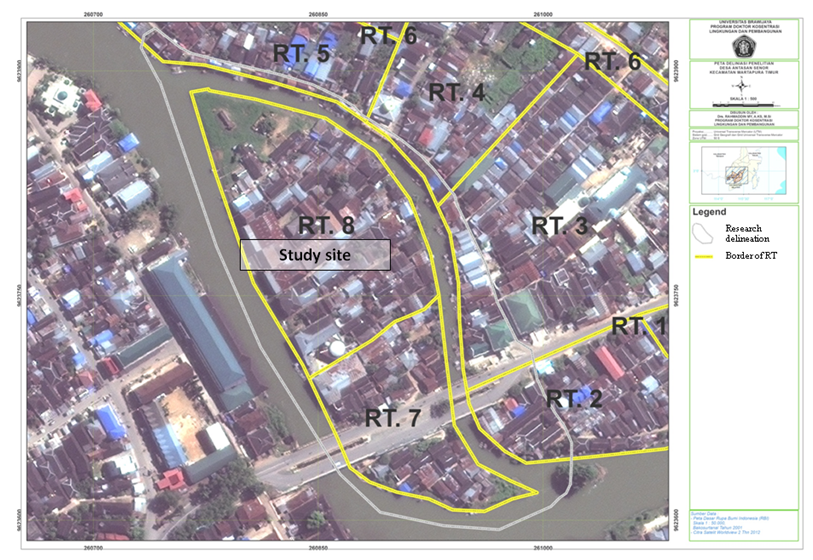 | Figure 1. Study Sites (Source: Bapedda Banjar) |
3. Results and Discussion
3.1. SWOT Analysis
- SWOT analysis was used to interpret the location of waste management planning, particularly in very complex conditions which internal and external factors may play important role. Through SWOT analysis, strengths and open opportunities were ascertainable as a positive factor, whereas weaknesses and threats as negative factor [16, 17]. Some strategies which called as core strategy must contain three principles such as:● Strategy that utilized the existing strengths and opportunities ● Strategies that solved the existing threats● Strategies that improve the weaknessesLiterally, SWOT is an acronym that consists of four concepts:● S (strength/force): a state or condition that is considered good.● W (weakness/problems): a state or condition that is considered as weaknesses or problems● O (opportunity/chance): a state or condition that exists or that will occur around the area that may useful for potential development● T (Threat/inhibition): a situation/condition that exists or that will occur around the area that is considered to inhibit/threatening potential development.Social engineering can be interpreted as a process of planning, mapping, and implementation in the context of the changes of structure and culture of a community's social base [9]. Each variables and indicators in the SWOT analysis were related to each other and it may directly affect on waste management in the bank Martapura River. Identification process of each variables and indicators were needed to determine the management strategies. SWOT variables identification describes as follow.
3.1.1. Strength
- a) Some people in the banks of Martapura River were already have the source of clean waterb) Some people were already has a place to shower, washing and toilet, although still used jointlyc) There was physical development in the Martapura River Bank by the government of Banjar Regencyd) Most people along the Martapura River Banks were at productive agee) Communities’ knowledge along the Martapura River Banks about waste management are at moderate levelf) Waste management were accepted well by communities along the banks of Martapura g) Waste management mechanism which created by the government of Banjar Regency has been clearh) Maintenance of facilities and waste management is running well.
3.1.2. Weaknesses
- a) There were still people’s habit who inclined littering the wastes into the riverb) There was long distance between temporary landfill and the Martapura River Banksc) There was long distance between landfill and the Martapura River Banksd) Many people were still has income less than Rp.1.000.000,- e) Education level of many people in the banks of Martapura river was still lowf) Communities in the Martapura river banks were not active in social organizations yetg) The ability to synthesize the knowledge about waste management in the Martapura river banks was still low h) There was no public figure who was concerned on waste management in the Martapura river banks
3.1.3. Opportunity
- a) Facilities and waste trucks were already adequateb) Landfill has been appropriate with the rulesc) Composting activities could reduce volume of wastes. It was conducted with collecting the wastes and separating the most of organic materiald) Reducing emissions of greenhouse gases (CH4, CO2)e) Composting activity were produced compost which has economic valuef) The presence of waste was provide new jobs for the communityg) Reducing the environmental burdenh) Utilization of methane gas which was flowed from productive waste through filtration process. It could be alternative energy as positive value for the community around the area of lanfill Cahaya Kencana in Banjar Regency
3.1.4. Threat
- a) They still very dependent to the riverb) The scope of waste management services in the Martapura District as much as 46.87%, while in the East Martapura District as much as 5.83%c) The level of waste management services in Banjar Regency was reached 11.64%d) The conditions of topography and demographics are not enough to support the waste management. It shown from the distance between the landfill which was very far from city central. Besides that, the road conditions was damaged which make the garbage trucks difficult to accesse) Waste accumulation were increased each year continually in line with population growth rate in Banjar Regencyf) Flood disaster was caused by accumulation of waste in Martapura Riverg) Dengue disease was caused by condition of dirty environment around the banks of Martapura River
3.2. IFAS Matrix
- Based on analysis of strengths and weaknesses variables, IFAS (Internal Factor Analysis Strategy) matrix was obtained (Table 1). This analysis was conducted especially on internal factors of waste management in the banks of Martapura River. There were many internal factors that support waste management in the banks of Martapura River. It was shown by total score of strength variable was higher than weakness variable, respectively 1.28 and 1.11 (Table 1).
|
3.3. EFAS Matrix
- According to the opportunities and threats variables which predetermined in SWOT analysis, metrics of EFAS (External Factor Analysis Strategy) analysis was obtained (Table 2). This metrics was focus on external environment factors of waste management in the banks of Martapura River.
|
3.4. Matrix of SWOT Analysis
- SWOT analysis (Table 3) is useful to determine strategies in optimizing the strength and opportunities. Besides that, it is necessary to minimize the weaknesses and threats. The existing indicators were used to determine strategies. Weakness or threats were not only plays as an inhibiting factor, but also as a supporting factor. It is also useful for optimizing the utilization of strengths and weaknesses [14, 18].
|
3.5. Analysis of Grand Strategy Matrix
- The results of internal and external data processing showed that there were variations of factor’s total score i.e. weaknesses, opportunities, strength, and threat respectively as much as 1.11; 1.23; 1.28 and 1.58. According to the results, total score of internal factor was lower than external factor, respectively 2.39 and 2.81. It suggests that external factors may affect the waste management in the banks of Martapura River more than internal factors. It is necessary to optimize external factor and solve the existing threats well, in order to improve waste management in the banks of Martapura River. Concern to internal factors such improve the strength and minimize the weaknesses may important too. Carpenter and Sanders [19] has been reported that external factors influenced more than internal factors. It means that the strategies which have been chosen to maximize the strengths and minimize the weaknesses and find out the existing opportunities.Beside to determine some alternative strategies, score of external and internal factors are also necessary to determine the coordinate’s point of development strategy, through the grand strategy matrix analysis. In this case, internal factors play role as horizontal axis (X), while external factors as vertical axis (Y). The value of the X coordinates = (1.28 to 1.11) = 0.17, while Y coordinates = (1.23 to 1.58) = - 0.35. The results of IFAS EFAS matrix and strategy quadrant of social engineering for waste management in the banks of Martapura River was shown in Fig.2.
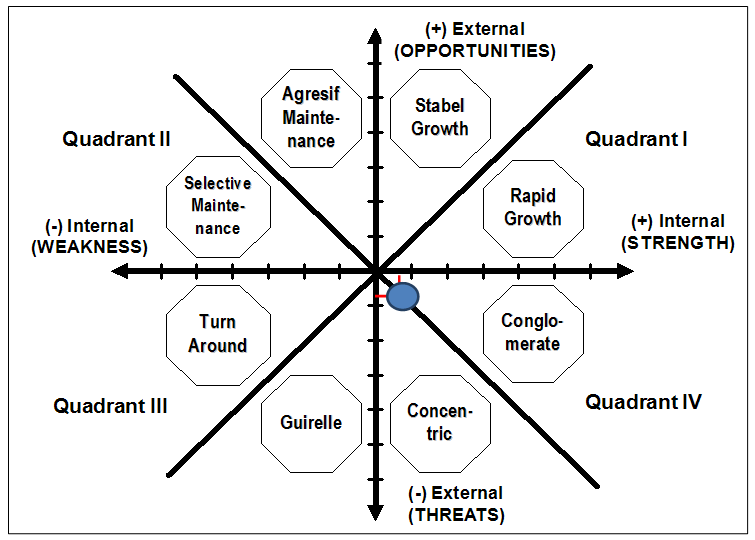 | Figure 2. Quadrant of Analysis of IFAS - EFAS |
4. Conclusions
- Social engineering strategy of waste management in the banks of Martapura River was in quadrant IV space G. Concentric strategy is suitable strategies and important to develop the empowerment model, which focus on object development strategy which carried out simultaneously in one cope/coordinator by one party. While the relevant strategies that was needed to be applied in the development of social engineering on waste management in Martapura River Bank is diversification strategy. This strategy was focus on the ability of community to face the emerging threats and improve their internal strengths during project process. This strategy was adopted for the long term. This strategy was adopted for the long term. Related with it, normative – re-education strategy was used as social engineering strategy. Besides that, this study was shown that social engineering is very important to change the behaviour of people toward waste management in the banks of Martapura River.
ACKNOWLEDGEMENTS
- Author thanks for the government of Banjar Regency, communities of Antasan Senor Ilir Village who has been support and help us in the field study. We also thanks Rector of Brawijaya University, Director of Graduate Program of Brawijaya University and Rector of Lambung Mangkurat University who gave opportunity to conduct this study.
 Abstract
Abstract Reference
Reference Full-Text PDF
Full-Text PDF Full-text HTML
Full-text HTML